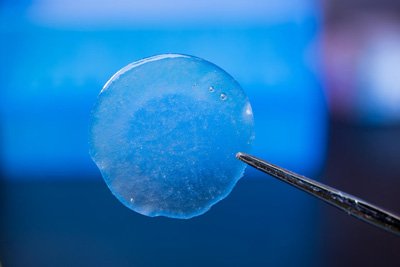Implantable film takes a direct hit at pancreatic cancer
Posted: 15 April 2016 | Victoria White, Digital Content Producer | 1 comment
Researchers from MIT and MGH have developed a small, implantable device that delivers chemotherapy drugs directly to pancreatic tumours…


Researchers from MIT and Massachusetts General Hospital (MGH) have developed a small, implantable device that delivers chemotherapy drugs directly to pancreatic cancer tumours.
In a study of mice, the researchers found that this approach was up to 12 times more effective than giving chemotherapy drugs by intravenous injection.
This thin, flexible film could also be adapted to treat other hard-to-reach tumours, according to the researchers.
The MIT and MGH team launched this project a little more than three years ago with a focus on pancreatic cancer, which has a five-year overall survival rate of less than 6 percent. Injections of chemotherapy drugs often fail not only because the pancreas is so deep within the body, but also because pancreatic tumours have few blood vessels, making it harder for drugs to get in. Also, pancreatic tumours are often surrounded by a thick, fibrous coating that keeps drugs out.
In hopes that getting drugs directly to the tumour site would improve treatment, the researchers engineered a flexible polymer film that is made from a polymer called PLGA, which is widely used for drug delivery and other medical applications. The film can be rolled into a narrow tube and inserted through a catheter, so surgically implanting it is relatively simple. Once the film reaches the pancreas, it unfolds and conforms to the shape of the tumour.
“Because it’s very flexible it can adapt to whatever size and shape the tumour will have,” Indolfi says.
Drugs are embedded into the film and then released over a pre-programmed period of time. The film is designed so that the drug is only secreted from the side in contact with the tumour, minimising side effects on nearby organs.


Researchers engineered a flexible polymer film that is made from a polymer called PLGA. CREDIT: Bryce Vickmark
Implant slowed tumour growth and reduced metastasis in mice
The researchers compared two groups of mice carrying transplanted human pancreatic tumours. One group received the drug-delivery implant loaded with the chemotherapy drug paclitaxel, and the other received systemic injections of the same drug for four weeks, which mimics the treatment human patients usually receive.
In mice with the drug-delivery implant, tumour growth slowed, and in some cases tumours shrank. The localised treatment also increased the amount of necrotic tissue (dead cancer cells that are easier to remove surgically). Additionally, by acting as a physical barrier, the film was able to reduce metastasis to nearby organs.
The researchers also found that after four weeks, the concentration of paclitaxel in the tumours of mice with the implanted device was five times greater than in mice that received injections. Also, because there are so few blood vessels in pancreatic tumours, the drug tended to remain there and not spread to nearby organs, preventing toxic effects in healthy tissues.
The researchers are now preparing to design a clinical trial for human patients. While they began this project with a focus on pancreatic cancer, they expect that this approach could also be useful in treating other tumours that are difficult to reach, such as tumours of the gastrointestinal tract.
“The greatest benefit of this device is the ability to implant it with minimally invasive procedures so we can give a tool to oncologists and surgeons to reach tumours that otherwise would be difficult to reach,” explained Laura Indolfi, a postdoc in MIT’s Institute for Medical Engineering and Science (IMES) and the MGH Cancer Centre.
Related topics
Drug Delivery
Related conditions
Pancreatic cancer
Related organisations
Massachusetts Institute of Technology



Do you intend to deliver this treatment intra arterially ?
thanks for your answer
Best Regards
M Sapoval MD PhD
Head Interventional Radiology Dep
Hôpital Européen Georges Pompidou
PAris , France